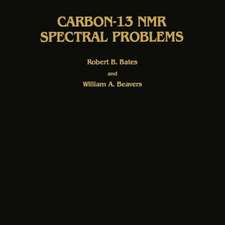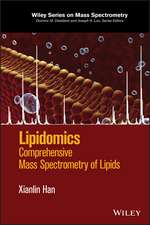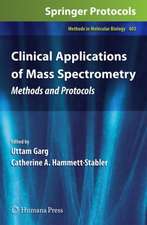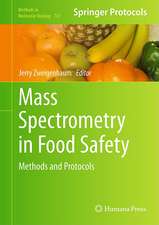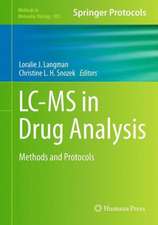Mass Spectrometry in the Biological Sciences
Editat de A. L. Burlingame, Steven A. Carren Limba Engleză Hardback – 5 ian 1996
Toate formatele și edițiile
| Toate formatele și edițiile | Preț | Express |
|---|---|---|
| Paperback (1) | 945.95 lei 6-8 săpt. | |
| Humana Press Inc. – 9 oct 2012 | 945.95 lei 6-8 săpt. | |
| Hardback (1) | 963.48 lei 6-8 săpt. | |
| Humana Press Inc. – 5 ian 1996 | 963.48 lei 6-8 săpt. |
Preț: 963.48 lei
Preț vechi: 1174.98 lei
-18% Nou
Puncte Express: 1445
Preț estimativ în valută:
184.45€ • 189.69$ • 153.02£
184.45€ • 189.69$ • 153.02£
Carte tipărită la comandă
Livrare economică 19 februarie-05 martie
Preluare comenzi: 021 569.72.76
Specificații
ISBN-13: 9780896033405
ISBN-10: 0896033406
Pagini: 570
Ilustrații: XII, 570 p.
Dimensiuni: 178 x 254 x 37 mm
Greutate: 1.44 kg
Ediția:1996
Editura: Humana Press Inc.
Colecția Humana
Locul publicării:Totowa, NJ, United States
ISBN-10: 0896033406
Pagini: 570
Ilustrații: XII, 570 p.
Dimensiuni: 178 x 254 x 37 mm
Greutate: 1.44 kg
Ediția:1996
Editura: Humana Press Inc.
Colecția Humana
Locul publicării:Totowa, NJ, United States
Public țintă
ResearchCuprins
Mass Spectrometry in the Health and Life Sciences.- Designing Time-of-Flight Mass Spectrometers for the Future: Multichannel Recording of Peptide Amino Acid Sequences.- The Role of Fourier Transform Ion Cyclotron Resonance Mass Spectrometry in Biological Research — New Developments and Applications.- Electrospray Ionization Mass Spectrometry: The Observation of Covalent, Ionic and Non-Covalent Interactions.- Using Deuterium Exchange and Mass Spectrometry to Study Protein Structure.- MALDI-TOF Mass Spectrometry in the Protein Biochemistry Lab: From Characterization of Cell Cycle Regulators to the Quest for Novel Antibiotics.- Chemistry, Mass Spectrometry and Peptide-Mass Databases: Evolution of Methods for the Rapid Identification and Mapping of Cellular Proteins.- Identification of Electroblotted Proteins by Peptide Mass Searching of a Sequence Database.- Mass Spectrometric Identification of Proteins Isolated By Two-Dimensional Gel Electrophoresis.- Infrared-Matrix-Assisted Laser Desorption/Ionization Mass Spectrometry (IR-MALDI-MS) of Proteins Electroblotted onto Polymer Membranes After SDS-PAGE Separation.- Picoliter Vials: a New Sample Handling Technique for Matrix-Assisted Laser Desorption/Ionization Mass Spectrometry.- Direct Neuropeptide Profiling of Single Neurons and Target Tissue by Matrix-Assisted Laser Desorption Ionization Mass Spectrometry.- Approaches to the Practical Use of MS/MS in a Protein Sequencing Facility.- Capillary Liquid Chromatography/Electrospray Mass Spectrometry with a Magnetic Sector Instrument for Accurate Mass Measurement of Peptide and Protein Mixtures.- Mass Spectrometric Methods for Peptide Sequencing: Applications to Immunology and Protein Acylation.- A Multifaceted Strategy for the Characterization of Recombinant gD-2, a PotentialHerpes Vaccine.- Identifying Unexpected Protein Modifications.- Mass Spectrometry in Carbohydrate Recognition Studies.- Mass Spectrometric and Tandem Mass Spectrometric Approaches to the Analysis of Glycoconjugates.- Structural Determination and Biosynthetic Studies of the Rhizobial Nod Metabolites: The Lipo-Chitin Oligosaccharides.- Mass Spectrometry as a Tool to Determine the Structures and Heterogeneity of Bacterial Lipooligosaccharides (LOS).- Applications of Tandem Liquid Chromatography/Mass Spectrometry in Drug Biotransformation and Quantification Studies.- Isoeicosanoids: Mass Spectrometry of Free Radical Oxidation Products Derived From Arachidonoyl Phospholipids.- Applications of Accelerator Mass Spectrometry in Toxicology: A Highly Sensitive Tool for Low-Level Isotope Measurements.- Characterization of Posttranscriptional Modification in Nucleic Acids by Tandem Mass Spectrometry.- The Future of DNA Sequencing: Methods and Applications.- Appendices.- Author Index.
Recenzii
The articles are uniformly well written...In summary, the book best serves the community interested in the characterization of proteins by mass spectrometer methods, but it contains valuable insights for analysis of other biomolecules as well.- Quarterly Review of Biology

